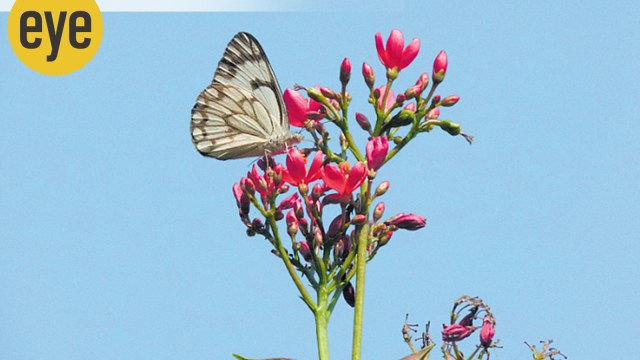Why I’m always curious about nature
Start questioning how flora and fauna have survived Earth for millions of years and it’s impossible to resist looking for answers
 How do dainty butterflies migrate cross-country without being blown off-course?
How do dainty butterflies migrate cross-country without being blown off-course? It’s a question I get asked most often (a real FAQ!): “How did you get interested in nature in the first place?” It’s followed by, “How does one get interested in nature?” My usual response is, “How can you not be interested in nature? All you have to do is to look around you and observe. And then be one hell of a nosey parker and begin asking yourself (and Googling!) questions: “Why, where, how, when and why not?”
Most of us, alas, look but we don’t see, let alone question. We love butterflies all decked up in their colourful frilly party frocks, but do we ever pause to question: how the hell do they precision-land on tiny blooms after flying as if totally under the influence? Do they even know which way is up? And how do they manage those massive cross-country migrations covering thousands of kilometres, without being blown off course by the gentlest of breezes?
Once you start asking questions and searching for answers, you’ll find yourself being inexorably drawn into ‘becoming interested in nature’. Just recently, I was idly thinking about dragonfly larvae – they spend two or three years underwater in the guise of ‘nymphs’. They are monsters, really, with a deadly prehensile hooked mask with which they terrorize tadpoles and small aquatic life. But if you live underwater, you’ll need gills to breathe. Gills that magically remove oxygen from the water and return carbon dioxide. So where are the gills in a dragonfly’s nymph?
Believe it or not, in its bottom! They’re called rectal gills and suck in the water, which runs over them and extract the dissolved oxygen and then jet it out again, enabling propulsion! So basically they’re giving themselves powerful enemas and jetting around with the help of them…
And then, came the follow-up question: ah yes, that’s all very well when they live underwater, but dragonflies don’t and you can’t use gills out of water… So? Well it seems that during their last ‘instar’ stage (the last moult the larvae go through before emerging) they develop spiracles – breathing tubes – on the upper part of their bodies and heads, which enable them to breathe air.
Right, so now I’m thinking, hey, we all emerged from the water at one point of time, when we must have used gills to breathe, but once in fresh air, had to develop lungs. Some of us stayed on land, but others – like whales and dolphins – returned to the water, but never regained their gills, which is why they have to surface to breathe. It would have really been wonderful if we had been able to retain both gills and lungs – no one would ever have drowned then when the Titanic went down! But, use it or lose it, and as we didn’t use our gills once we emerged from the water, we lost them!
Another matter I got curious about was how carnivores like tigers and wild dogs trained their young to become self-sufficient hunters. When cubs are young and have the attention span of fleas, they often sabotage their mom’s hunting endeavours. Then, a growl and a frosty look and the cubs crouch down, their big eyes wide, as their mom brings down the dinner, and only go to her when called. As they grow, she brings them injured fawns, on which to practice their hunting skills. By the time they are two years old the cubs are more or less independent and efficient hunters.
Well, I tried ‘training’ my last dog to sit and stay and only come when the release command was given, but soon realized that the little ustad had begun training me! He would sit (looking martyred) and wriggle on his bottom, and I knew that he’d come running over any moment, so before he could do that, I gave him the release command. He was telling me when I ought to give him the command instead of me doing so when I thought would be appropriate! He had read my body language. I wonder what would have happened if a tiger cub tried that stunt on his mom!
Everything in nature is worth becoming curious about. Ever thought about what recipe a mango tree uses to produce its rich sweet mangoes? All it seems to have as its ingredients is soil, water, sun, a few minerals and air. Or how flowers produce their richly coloured and patterned petals, some which look different in ultraviolet light, especially evolved to safely guide in drunken butterflies and other insects, like runway lights do for aircraft?
Luckily, there are millions of people who have become curious and spent the better part of their lives trying to figure out their fascinations, doggedly unearthing secret after secret and miracle after miracle as they do. Nearly every creature has its benefactor. Sadly many of the subjects of their studies suffer terrible indignities ‘for the sake of science.’
One thing is certain: once you get ‘hooked’ there is no turning back and you’ll be asking questions hopefully for the rest of your life. So look and observe everything, even bird droppings! Long ago a bird dropping that I glanced on a kumquat bush moved along the midrib of a leaf I had spotted it on. It turned out to be a caterpillar – which I subsequently raised and watched turn green and gluttonous, then pupate, meditate and fast, and finally emerge as a gorgeous lime-butterfly. From glutton to fasting hermit to nectar-sipping socialite. Then I read about the magic that happened during this transformation; it was truly mind-boggling and alas, is another story!



- 01
- 02




























